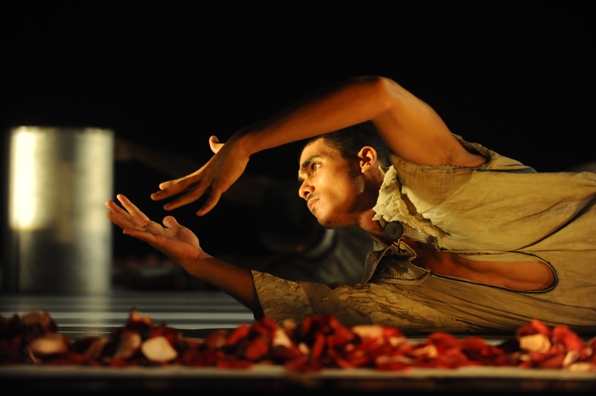
Itzik Cohen is a choreographer whose work I encountered for the first time in his dance/theatre work Idyll, which premiered in the Suzanne Dellal Summer Dance Festival on August 19, 2011. As an observer of dance, I am less interested in swift summaries and instant evaluations than in following the dance scene and its activity over time, becoming acquainted with a choreographer’s style not only over time and several works, but often through repeated viewing of the same work. Usually at some point in this process I have the urge to comment. When I see someone’s work for the first time – in any discipline – there is usually only one question in my mind: Will it interest me to see this person’s work again?
In this instance, the answer is yes, and here’s why.
Idyll is very ambitious in its scale for a beginning choreographer, taking on a triple challenge as an evening-length work, an interdisciplinary dance/theatre piece, and in its stated relationship to the play Thrill My Heart by the iconic Israeli writer Hanoch Levin. Poetic, playful and terse, Levin’s texts are the essence of his plays, an imposing obstacle to any adaptation or translation of his work. Thrill My Heart, a play discovered after Levin’s death in 1999, is a tale of unrequited love, neurotic denial, the sustaining power of a dream and the strange affinity between dream and delusion. Judge Lamka is the perpetual suitor of would-be singer La La La, persisting in his love despite her constant rejection and demonstrated preference for a never-ending sequence of “doctors” and “coaches” who escort her everywhere. Lamka’s faithful friend Pshonshiak tries to open his eyes, but to no avail. Lamka is out there on the street corner, every Saturday at 8pm. Pshonshiak leads a middling life with Kaha-kaha (Hebrew: so-so), the four protagonists caught in a cycle of desire and frustration.

Cohen evokes the feel of Levin’s work through images and association, rather than a one to one equivalence. This choice works well for Idyll in two respects: those unfamiliar with Levin’s work can easily relate independently to Idyll, and those who admire Levin’s work are spared the potential horrors of an illustrative adaptation. Within the cast of nine, one can identify singer and suitor, but the theatrical aspect of this work is grounded in methods and artistic language rather than narrative structure and character. Working with movement, text (both spoken by the dancer/actors onstage and as occasional voice-over), music and visual elements, Cohen expresses his interpretation of the emotional environment of Levin’s work – colorful, sexual, humorous, bitter, and poignant.
The stage is strewn with red flowers, a memento mori with their lush sensuality and suggestion of early demise: “Gather ye rosebuds while ye may.” Several silver cylinders are placed on the stage, and come into play in different ways throughout the performance. A free standing door is a more significant symbolic presence, and is used to good effect in the delightful opening sequence. The door also establishes a visual barrier between the suitor and the object of his desire.
Indefatigable in his pursuit of love, oblivious, not only to rejection, but to any knowledge of the woman herself, he repeats his advances (rather cheerfully, considering the circumstances) offering the tried and true aphrodisiacs: flowers and money. The lady singer is obsessively preoccupied with the fame, youth and beauty that constantly seem to elude her grasp. Yet while they stand out as distinct characters, their motivations and desires are seen within the context of the imaginative community created onstage – somewhat comically grotesque individuals searching for love and immortality.
As a whole, the work is fun to watch, with a carnivalesque quality to the characters and movement. While there is an overall theme, there is more atmosphere than narrative, with most scenes contributing layers of associations rather than driving plot. This worked well for me, except for one scene with three male dancers in black corsets that left me puzzled without leading me to any interesting avenues of thought.
Levin’s play is very much a man’s story. La La La may be the object of Lamka’s desire, but we see only brief glimpses of the woman, her thoughts and feelings. The theme of male friendships, with their aggressive mix of bonding and rivalry is expressed in Idyll as well. In one particularly strong scene the cylinders become the setting for a tribal circle, evoking an aura of ritual that merges with a gestural language of the street – shoving, pushing and upraised arms. In a departure from Levin’s play, Idyll brings the women to the forefront, taking the audience into the singer’s dressing room with her futile primping, and letting her have center stage and sing (which never happens in Levin’s play). The comic effect of these moments is undeniable, but they also invite empathy, adding texture to the work as a whole.
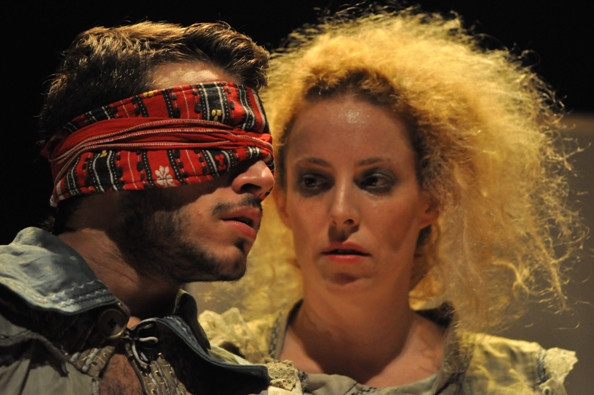
Most intriguing is the focus on a character that one might be tempted to identify with that of Kaha-kaha in Levin’s work, the dreary neglected wife of Pshonshiak, who sleeps so much that she is too tired to do anything but sleep. Performed by Kim Gordon, this woman is a contrast to the sultry singer, with her drab clothing, dull eyes and a lost look surrounded by a pale halo of wild hair; she cannot even aspire to youth and beauty. Already in place onstage as the audience enters, she gazes blankly outward at the world. She is present throughout most of the work; in a supporting role, the plain friend, the servant, the facilitator. Yet the inner voice of her emotions is an integral part of this work, in the movement and expression of the dancer. One almost feels that if there is a narrative perspective in this work, it is hers, and she endows Idyll with some of its most poignant and poetic moments.
Choreography: Itzik Cohen
Producer and Co-Creator: Refael Adenayev
Dramaturgy: Yael Navie
Original and Edited music: Didi Erez
Costumes: Barak Aviam
Set Designer: Alon Zehavi
Dancers/actors/creators: Yasmin Weiss, Mor Bar-Zakai, Noa Sagie, Kim Gordon, Rotem Nachmany, Avi Matzliah, Alon Malka, Dor Raybi, Robin Kain

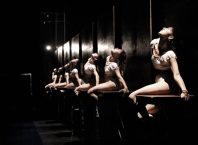
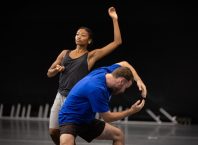
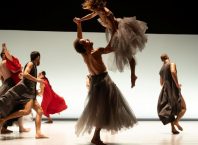


Comments are closed.